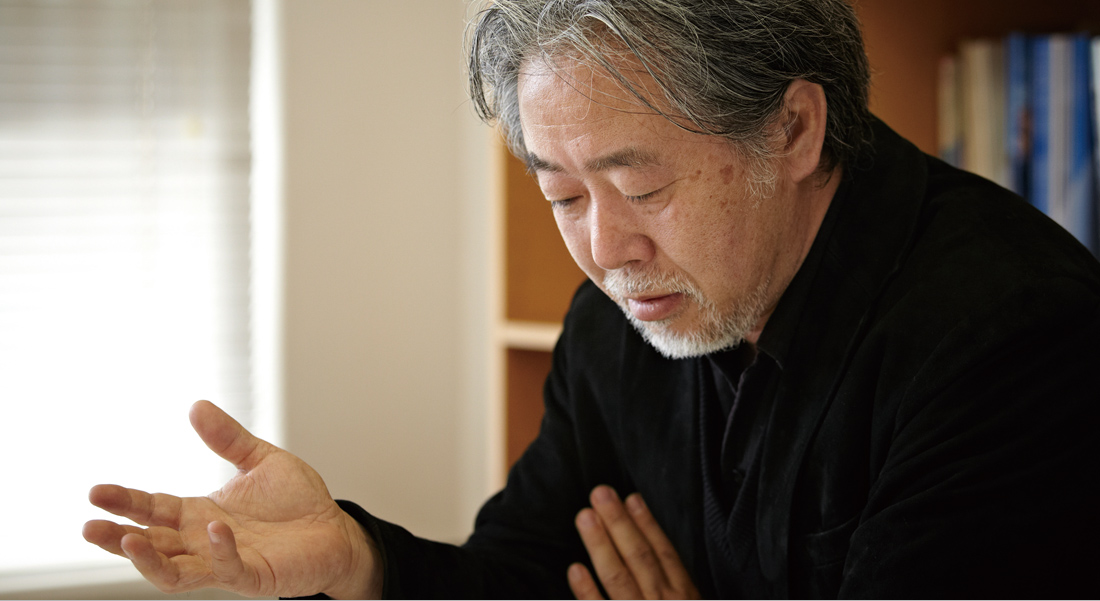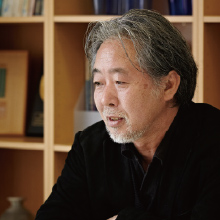Feature

FROM OUTSIDE2018.12.21
How Can Lighting Help to Face
One’s Emotional Problems? #2
Architect/ Hiroshi Naito
Taking Sides
The general public thinks that architects are taking sides of the wealthy―the capital and society’s side. The disaster victims may not even think about asking for support from architects. For them, architects are not the go-to person for help. This is clear, and I think for various designers such as architects, lighting designers, and product designers, it is a situation where they are being asked, “Whose side are you on?”
When we look back at the past ten years, there have been many discussions about energy conservation and global environment for ecology’s sake. Switching to LED was a natural flow, and it made sense. But then, something that goes against the flow happened. We relied on nuclear power generation, believing it doesn’t emit CO2, it’s eco-friendly and safe. Although it had its downsides, we rationalized it saying it “can’t be helped.” All this has turned upside down with the earthquake disaster. We were questioned whether it is really eco-friendly and safe. Now, it is common knowledge even amongst housewives that the logic of energy conservation and eco-friendliness is highly questionable.
Since lighting has been established upon an easy logic, it may be eradicated from society if the industry doesn’t straighten out (laughs). The same thing can be said about the architects, too. Maybe the architects are in a lot more danger (laughs).
Saving Life with Light
There is a story of when the Ansei great earthquake struck, rice straws were lit with fire to lead the villagers to higher ground. This is a story about light. I think there are many historic stories like this where lights saved lives. These types of stories should be spread more, so that it may raise questions about how much lighting designers are contributing designs for the damaged area.
For example, the Meiji Sanriku Earthquake struck around seven o’clock in the evening. I think lighting designers should consider situations of people evacuating in the dark. It would be good to have some type of lighting that the townspeople are very familiar with and know that they can always depend on when they have to evacuate at night. I feel that the lighting designers should speak up about these kinds of stories. In reality, tenders are decided between a lighting manufacturer salesperson and the local government upon prices for a street light by the unit. This is why towns end up with many ordinary boring street lights. It can be said that the lighting designers are abandoning their responsibilities. There is hope for design to be associated with the living conditions and lives of ordinary people there.
I think things that are useful are things that are cherished in our daily lives. It has to be something that everybody uses or things that everybody likes. It is probably like planting cherry blossoms in the affected areas. I think there are things that the lighting designers can propose for the damaged area, and by doing so, important things may be discovered. Although the Great East Japan Earthquake occurred during the daytime, it is possible that an earthquake to strike during the night. Nobody knows when an earthquake will hit Tokyo. There could be chances of relying on battery operated light fixtures for evacuation when there is a blackout over a wide area.

#1 Symposium “Lighting Design: Trajectory and Outlook”
#2 Symposium “Asian Lighting Design Showcase/Six Designers Discuss Asian Lighting Style”
#3 Seminar: “Asian Cool & Hot!!”
#4 Lighting Design Session “Lighting Design Quiz: Understanding the Latest Trends and discovering the wonders in the Lighting Design Industry”
#5,6 Ariake Akari Studio
PROFILE
 Architect/ Hiroshi Naito
Architect/ Hiroshi Naito
Born in 1950 in Kanagawa, Japan. Graduated from Department of Architecture and Architectural Engineering, Faculty of Science and Engineering, Waseda University in 1974. Attained his master’s degree in 1976. Opens Naito Architect & Associates in 1981 after working for Fernando Higueras (Madrid) and Kiyonori Kikutake. Appointed as Professor in the Department of Civil Engineering at the University of Tokyo from 2002 to 2011. Chief Juror of the Good Design Award from 2007 to 2009. Vice President of the University of Tokyo from 2010 to 2011.
Honorary Professor of the University of Tokyo since 2011. Major works include “Toba Sea-Folk Museum” 1992, “Chihiro Art Museum” 1997, “The Shimane Arts Center” 2005. Among many other award winning architectural works, Naito is also a prolific author.
How Can Lighting Help to Face One’s Emotional Problems? #3 Grasping the Hearts of the General Public
